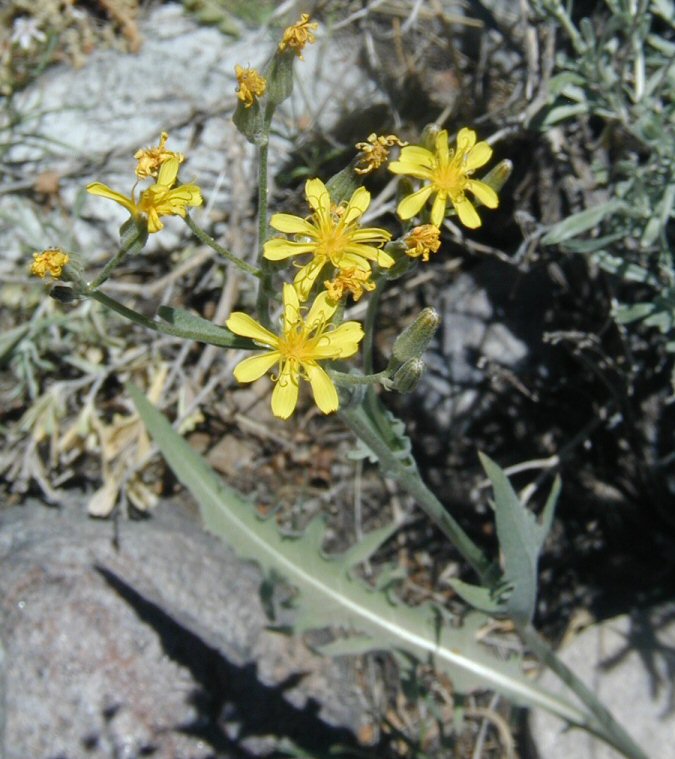Perennials, 25-60 cm (taproots stout or slender, caudices swollen, simple or branched, covered with brown leaf bases). Stems 1-2, erect, branched (proximal branches elongate, branched distally), ± tomentose-canescent. Leaves basal and cauline; petiolate (petiole bases clasping); blades elliptic-lanceolate, 10-40 × 2-9 cm, margins pinnately lobed (lobes remote or close, entire or dentate), apices acute or acuminate, faces densely or sparsely gray-tomentose. Heads (10-)20-60, in ± flat-topped, compound, corymbiform or paniculiform arrays. Calyculi of 6-8, narrowly triangular, tomentulose bractlets 2-4 mm. Involucres narrowly cylindric, 10-16 × 3-5 mm. Phyllaries 7-10, (medially green) lanceolate, 10-13 mm (margins scarious), apices acute, abaxial faces ± tomentulose, sometimes with greenish eglandular setae, adaxial with fine hairs. Florets 7-12; corollas yellow, 14-30 mm. Cypselae yellow or golden brown, subcylindric, 6-9 mm, tapered distally, ribs 10-12 (smooth); pappi dusky white, 7-10 mm. 2n = 33, 44, 55, 88.
Flowering May-Jul. Open rocky ridges, dry slopes, open forests; 800-3900 m; Alta., B.C., Sask.; Ariz., Calif., Colo., Idaho, Mont., Nev., N.Mex., Oreg., Utah, Wash., Wyo.
Crepis intermedia is a somewhat unnatural group of polyploid apomicts that combines the features of multiple species, including C. acuminata, C. pleurocarpa, C. modocensis, and C. atribarba (E. B. Babcock 1947). The plants are usually over 25 cm, with leaves deeply pinnately lobed (gray-tomentose, cleft about halfway to midribs), with acuminate apices, and more or less flat-topped arrays of heads. The leaves vary greatly in size and lobing and are always gray-tomentose. The number of heads per plant is usually more than 20.
General: Perennial, 25-60 cm tall; stems 1-2, erect, branched above, more-or-less gray tomentose; plants with milky sap; caudex somewhat woody, swollen, taproot stout to slender.
Leaves: Basal and cauline, alternate, elliptic-lanceolate in outline, 10-40 cm long, 2-10 cm wide, the upper blades reduced, sparsely to densely gray-tomentose, margins pinnately lobed, the lobes triangular to linear, entire to dentate; blades petiolate, the bases clasping.
Flowers: Heads solitary or in corymb-like arrays; bractlets (subtending the involucre) mostly 8, linear to narrowly lanceolate, 6-9 mm long, equal to or surpassing the ray flowers, joined at the base; involucre hemispheric to somewhat cylindric, 5-10 mm wide; phyllaries oblong, 5-8 mm long; ray flowers mostly 8, 7-12 mm long, white, reddish, or violet; disk flowers perfect, 10-20, 4-5 mm long, yellow; flowers July-October.
Fruits: Achene, 5.5-9 mm long, yellow to brownish, 10-12 ribbed, the apex tapered; pappus 7-10 mm long, dusky to white, the bristles minutely barbed.
Ecology: Rocky ridges, slopes, forest openings; 1200-2600 m (3900- 8600 ft); Coconino, Navajo, Mohave, and Yavapai counties; western Canada, western U.S.
Notes: Crepis acuminata (tapertip hawksbeard) is very similar to C. intermedia, but it has fewer phyllaries (5-8) and fewer flowers per head (5-10). Crepis occidentalis (gray or western hawksbeard) is distinguished by plants 8-40 cm tall; inflorescences in loose corymb-like arrays; involucres cylindric, 5-10 mm wide; phyllaries are 10-13, stipitate-glandular; ray flowers are 10-30. Two ssp. occur within our range and are differentiated as follow: ssp. occidentalis has 7-8 or 10-13 phyllaries and 18-30 ray flowers; ssp. costata has 8 phyllaries and 10-14 ray flowers. Cichorium intybus (chicory) is an introduced perennial with milky sap, 30-170 cm tall, stems usually solitary, branched; leaves are basal and cauline, oblanceolate in outline, usually 8-25 cm long, 1-8 cm wide, with toothed to pinnately cleft margins; heads consist of ray flowers only, blue to seldom pink or white, borne in clusters in the axils of reduced upper cauline leaves; achenes are 2-3 mm long, the surface transversely wrinkled; the pappus consists of numerous whitish scales. It flowers June-October and typically occurs along roadsides and in disturbed habitats.
Editor: Springer et al. 2008









